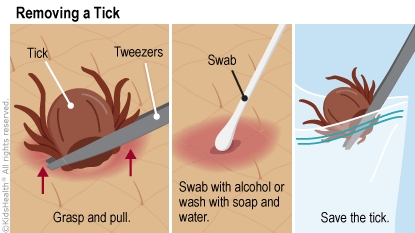Your child had a tick bite. Most tick bites are harmless, but some ticks carry germs that can cause illness. These instructions will help you care for your child. Call your health care provider if you see any signs of illness.

Can a tick bite cause illness? Most tick bites do not cause illness. But sometimes tick bites can lead to problems like Lyme disease, Rocky Mountain spotted fever, or ehrlichiosis. Typical symptoms of these illnesses include fever, rash, headache, and muscle and joint pain. Sometimes more serious symptoms happen. All these illnesses are treated with antibiotics.
How can I protect my child from another tick bite? To help prevent future tick bites:
- Have your child wear long-sleeved shirts and long pants (and tuck the pant legs inside socks) when in wooded areas.
- On children older than 2 months, use insect repellent containing 10–30% DEET before outdoor activities. Apply only once a day, and wash off with soap and water when you come back inside for the day. Don't use repellents with a concentration of DEET above 30%.
- Spray permethrin insect repellent on your child's clothing and gear. Let it dry completely before touching it. Do not spray permethrin on the skin. Do not use permethrin on a baby's clothes since they may suck on the fabric.
- Check your child's whole body for any ticks after they have been outdoors. Pay special attention to the scalp, behind the ears, around the neck, and under the arms.
What is the best way to remove a tick if my child gets another one? To remove a tick:
- Use tweezers to grasp the tick firmly at its head or mouth, next to the skin.
- Pull firmly and steadily on the tick until it lets go (do not twist or yank the tick).
- Swab the bite with rubbing alcohol or wash with soap and water.
- Check to see if any parts of the tick remain in the skin. If so, call your health care provider.
- Save the tick in a closed container or a zippered plastic bag in case your health care provider wants to do testing on it.



